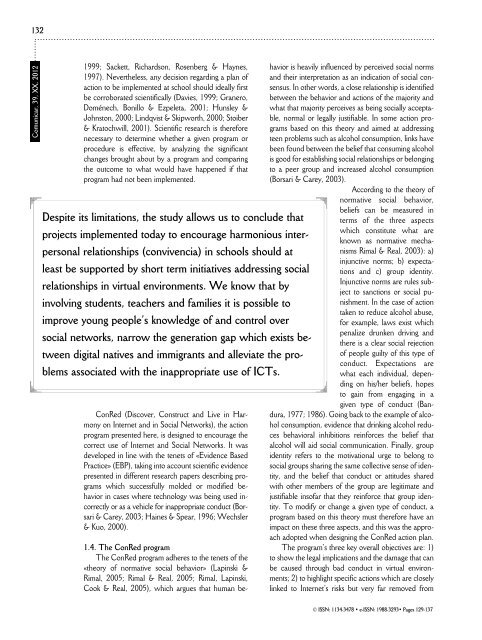Comunicar 39-ingles - Revista Comunicar
Comunicar 39-ingles - Revista Comunicar
Comunicar 39-ingles - Revista Comunicar
You also want an ePaper? Increase the reach of your titles
YUMPU automatically turns print PDFs into web optimized ePapers that Google loves.
132<strong>Comunicar</strong>, <strong>39</strong>, XX, 20121999; Sackett, Richardson, Rosenberg & Haynes,1997). Nevertheless, any decision regarding a plan ofaction to be implemented at school should ideally firstbe corroborated scientifically (Davies, 1999; Granero,Doménech, Bonillo & Ezpeleta, 2001; Hunsley &Johnston, 2000; Lindqvist & Skipworth, 2000; Stoiber& Kratochwill, 2001). Scientific research is thereforenecessary to determine whether a given program orprocedure is effective, by analyzing the significantchanges brought about by a program and comparingthe outcome to what would have happened if thatprogram had not been implemented.Despite its limitations, the study allows us to conclude thatprojects implemented today to encourage harmonious interpersonalrelationships (convivencia) in schools should atleast be supported by short term initiatives addressing socialrelationships in virtual environments. We know that byinvolving students, teachers and families it is possible toimprove young people’s knowledge of and control oversocial networks, narrow the generation gap which exists be -tween digital natives and immigrants and alleviate the problemsassociated with the inappropriate use of ICTs.ConRed (Discover, Construct and Live in Har -mony on Internet and in Social Networks), the actionprogram presented here, is designed to encourage thecorrect use of Internet and Social Networks. It wasdeveloped in line with the tenets of «Evidence BasedPractice» (EBP), taking into account scientific evidencepresented in different research papers describing programswhich successfully molded or modified be -h a v i o r i n c a s e s w h e r e t e c h n o l o g y w a s b e i n g u s e d i n -cor rectly or as a vehicle for inappropriate conduct (Bor-sari & Carey, 2003; Haines & Spear, 1996; Wechsler& Kuo, 2000).1.4. The ConRed programThe ConRed program adheres to the tenets of the«theory of normative social behavior» (Lapinski &Rimal, 2005; Rimal & Real, 2005; Rimal, Lapinski,Cook & Real, 2005), which argues that human be -havior is heavily influenced by perceived social normsand their interpretation as an indication of social consensus.In other words, a close relationship is identifiedbetween the behavior and actions of the majority andwhat that majority perceives as being socially acceptable,normal or legally justifiable. In some action programsbased on this theory and aimed at addressingteen problems such as alcohol consumption, links havebeen found between the belief that consuming alcoholis good for establishing social relationships or belongingto a peer group and increased alcohol consumption(Borsari & Carey, 2003).According to the theory ofnormative social behavior,beliefs can be measured interms of the three aspectswhich constitute what areknown as normative mechanismsRimal & Real, 2003): a)injunctive norms; b) expectationsand c) group identity.Injunctive norms are rules subjectto sanctions or social pu -nishment. In the case of actiontaken to reduce alcohol abuse,for example, laws exist whichp e n a l i z e d r u n k e n d r i vi n g a n dthere is a clear social rejectionof people guilty of this type ofconduct. Expectations arewhat each individual, dependingon his/her beliefs, hopesto gain from engaging in agiven type of conduct (Ban-dura, 1977; 1986). Going back to the example of alcoholconsumption, evidence that drinking alcohol reducesbehavioral inhibitions reinforces the belief thatalcohol will aid social communication. Finally, groupidentity refers to the motivational urge to belong tosocial groups sharing the same collective sense of identity,and the belief that conduct or attitudes sharedwith other members of the group are legitimate andjustifiable insofar that they reinforce that group identity.To modify or change a given type of conduct, aprogram based on this theory must therefore have animpact on these three aspects, and this was the approachadopted when designing the ConRed action plan.The program’s three key overall objectives are: 1)to show the legal implications and the damage that canbe caused through bad conduct in virtual environments;2) to highlight specific actions which are closelylinked to Internet’s risks but very far removed from© ISSN: 1134-3478 • e-ISSN: 1988-3293• Pages 129-137
















